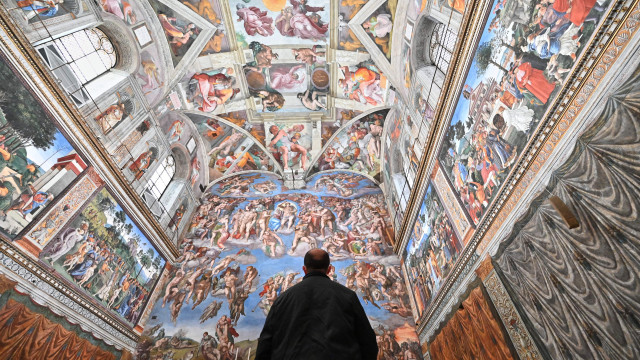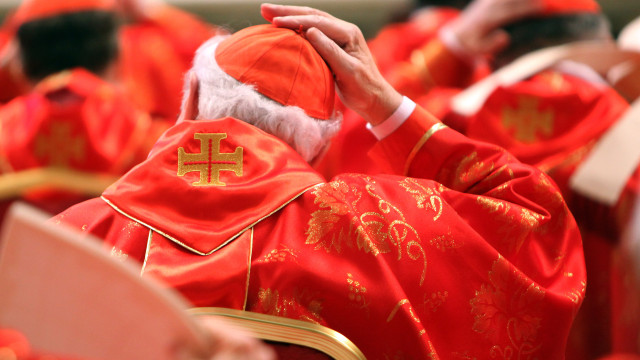





























See Also
See Again
© Getty Images
0 / 30 Fotos
Religious switching
- What
is religious switching? This refers to a process in which people
change the religious group they are affiliated with, often since childhood.
© Getty Images
1 / 30 Fotos
Religious identity
- The switch of religions is typically from the one they grew up with to a new religious identity they find in adulthood.
© Getty Images
2 / 30 Fotos
Switch vs. conversion
-
The term switch is used instead of conversion
because some religious upbringings are cultural. What's more, it includes situations where someone switches from their childhood religion to no religious affiliation at all.
© Getty Images
3 / 30 Fotos
Denominations don't count
- Switching
between religious denominations is not taken into consideration in
the context of the study. This means, if a person switches from one
form of Christianity to another, this is not considered a switch in
the study.
© Getty Images
4 / 30 Fotos
Distinction
- This
distinction is quite important. If denomination was included
in the study, the numbers would likely be much higher than what is
reported by the Pew Research Center.
© Getty Images
5 / 30 Fotos
Nations where switching is rare
- There
are a number of countries in which religious switching is extremely
rare. About 95% of adults in nations such as India, Tunisia,
Nigeria, and Bangladesh, among others,
reportedly retain their childhood religion into adulthood.
© Getty Images
6 / 30 Fotos
Other nations
- But
other nations across Western Europe, South and North America, and
East Asia are seeing much higher numbers of religion switching, to
the point where it is considered common.
© Getty Images
7 / 30 Fotos
South Korea
- In
South Korea, it is reported that approximately half of the nation’s
adults do not identify with the religion that they were brought up
in. South Korea reports the largest
percentage of adults in this context.
© Getty Images
8 / 30 Fotos
Spain
- Spain
follows suit. The Iberian nation reports that 40% of Spanish adults
no longer identify with the religion they were raised within.
© Getty Images
9 / 30 Fotos
Canada
- Canada is also experiencing significant
shifts. The North American nation reports that 38% do not subscribe to their
childhood religion.
© Getty Images
10 / 30 Fotos
Sweden
- Sweden
echos Canada with a figure of 37%, representing
the percentage of adults that no longer follow the religion they
were brought up within.
© Getty Images
11 / 30 Fotos
Netherlands and UK
- In
the Netherlands, Dutch adults are following a similar trend, in
which 36% of adults also do not identify with their childhood
religion.
The United Kingdom has the same
percentage.
© Getty Images
12 / 30 Fotos
Australia, France, Germany, and Japan
- Australia,
France, Germany, and Japan all report that 34% of their adult
population no longer adheres to their religious upbringing.
© Getty Images
13 / 30 Fotos
Singapore
-
In Singapore, the vastly multicultural island
reports a similar trend, with 30% of its adult population reporting
to no longer identify with their childhood religion.
© Getty Images
14 / 30 Fotos
United States and Chile
- In
the United States, the numbers are also on the up. According to the
study, 28% of Americans do not identify with the religion that they
were brought up in. Chile also has the
same percentage.
© Getty Images
15 / 30 Fotos
Brazil
- Brazil,
too, is facing this shift. The report notes that 21% of Brazilian
adults no longer identify with the religion they inherited from
their parents.
© Getty Images
16 / 30 Fotos
Uptick reported
-
The list goes on with an uptick in switching reported, in
general, throughout every continent in the world.
© Getty Images
17 / 30 Fotos
What are the trends?
- So
what are people converting to? What religious traditions are on the
rise? This is likely the most fascinating question that the study
highlights in its findings.
© Getty Images
18 / 30 Fotos
Religiously unaffiliated
- The
vast majority of religious switching has actually been attributed to
“religiously unaffiliated.” What does this mean? This consists
of atheists, agnostics, or those who described their religious affiliations as "nothing in particular.”
© Getty Images
19 / 30 Fotos
Disaffiliation
- How
else can this be understood? The study refers to this switch as
“disaffiliation,” meaning people are leaving their religions and
choosing to no longer identify with any particular religion.
© Getty Images
20 / 30 Fotos
Many are leaving Christianity
- The
vast majority of the people who are part of this “disaffiliation”
category were raised as Christians. We can use the example of Sweden
to demonstrate how 29% of adults who were raised as Christians now
describe themselves as disaffiliated.
© Getty Images
21 / 30 Fotos
Buddhism also experiencing a lot of losses
- It’s
not just Christianity. Buddhism is the second religion that is
losing the most followers. In Japan, 23% of adults were raised as
Buddhists, but do not identify with any religion.
© Getty Images
22 / 30 Fotos
Lack of identification in South Korea
- Similarly,
in South Korea, 13% of adults also report being raised as Buddhists,
but no longer identify with any religion
at all. This doesn’t necessarily mean they are atheists, but it’s
more of a lack of identification with any religion at all.
© Getty Images
23 / 30 Fotos
Some switching to Christianity
- Oddly,
in South Korea, 9% of adults who were raised with no
religious affiliation ended up switching to Christianity in adulthood.
© Getty Images
24 / 30 Fotos
Significant percentages in some nations
- Disaffiliation
from Buddhism is particularly high in nations such as South Korea,
Singapore, and Japan. About one in 10
adults in Singapore, South Korea, and South Africa, have switched
between religions, meaning they were previously affiliated with one
religion and are now affiliated with another.
© Getty Images
25 / 30 Fotos
Global trends
- While
these statistics do intend to give an idea of global trends, the study
only tracks behavior in 36 nations. Therefore, the data doesn’t
change the fundamental truths that we know about the world’s most
prominent religions.
© Getty Images
26 / 30 Fotos
The role of Christianity
- Christianity
remains the world’s largest and most widespread religion in the
world. Although no precise data exists, research indicates that it
remains one of the world’s most predominant religions.
© Getty Images
27 / 30 Fotos
The role of Islam
- Islam
is the world’s second-largest religion and the fastest growing
religion in the world, with nearly two
billion followers across the globe.
© Getty Images
28 / 30 Fotos
Billions of religious people
- Although
the category of "religiously unaffiliated" is gaining quite a
bit of traction and has experienced “the largest net
gains,” there are still billions of people around the world
practicing and adhering to organized religion. Sources:
(Pew Research Center) See
also: Everything
you need to know about Shinto, Japan's oldest religion
© Getty Images
29 / 30 Fotos
© Getty Images
0 / 30 Fotos
Religious switching
- What
is religious switching? This refers to a process in which people
change the religious group they are affiliated with, often since childhood.
© Getty Images
1 / 30 Fotos
Religious identity
- The switch of religions is typically from the one they grew up with to a new religious identity they find in adulthood.
© Getty Images
2 / 30 Fotos
Switch vs. conversion
-
The term switch is used instead of conversion
because some religious upbringings are cultural. What's more, it includes situations where someone switches from their childhood religion to no religious affiliation at all.
© Getty Images
3 / 30 Fotos
Denominations don't count
- Switching
between religious denominations is not taken into consideration in
the context of the study. This means, if a person switches from one
form of Christianity to another, this is not considered a switch in
the study.
© Getty Images
4 / 30 Fotos
Distinction
- This
distinction is quite important. If denomination was included
in the study, the numbers would likely be much higher than what is
reported by the Pew Research Center.
© Getty Images
5 / 30 Fotos
Nations where switching is rare
- There
are a number of countries in which religious switching is extremely
rare. About 95% of adults in nations such as India, Tunisia,
Nigeria, and Bangladesh, among others,
reportedly retain their childhood religion into adulthood.
© Getty Images
6 / 30 Fotos
Other nations
- But
other nations across Western Europe, South and North America, and
East Asia are seeing much higher numbers of religion switching, to
the point where it is considered common.
© Getty Images
7 / 30 Fotos
South Korea
- In
South Korea, it is reported that approximately half of the nation’s
adults do not identify with the religion that they were brought up
in. South Korea reports the largest
percentage of adults in this context.
© Getty Images
8 / 30 Fotos
Spain
- Spain
follows suit. The Iberian nation reports that 40% of Spanish adults
no longer identify with the religion they were raised within.
© Getty Images
9 / 30 Fotos
Canada
- Canada is also experiencing significant
shifts. The North American nation reports that 38% do not subscribe to their
childhood religion.
© Getty Images
10 / 30 Fotos
Sweden
- Sweden
echos Canada with a figure of 37%, representing
the percentage of adults that no longer follow the religion they
were brought up within.
© Getty Images
11 / 30 Fotos
Netherlands and UK
- In
the Netherlands, Dutch adults are following a similar trend, in
which 36% of adults also do not identify with their childhood
religion.
The United Kingdom has the same
percentage.
© Getty Images
12 / 30 Fotos
Australia, France, Germany, and Japan
- Australia,
France, Germany, and Japan all report that 34% of their adult
population no longer adheres to their religious upbringing.
© Getty Images
13 / 30 Fotos
Singapore
-
In Singapore, the vastly multicultural island
reports a similar trend, with 30% of its adult population reporting
to no longer identify with their childhood religion.
© Getty Images
14 / 30 Fotos
United States and Chile
- In
the United States, the numbers are also on the up. According to the
study, 28% of Americans do not identify with the religion that they
were brought up in. Chile also has the
same percentage.
© Getty Images
15 / 30 Fotos
Brazil
- Brazil,
too, is facing this shift. The report notes that 21% of Brazilian
adults no longer identify with the religion they inherited from
their parents.
© Getty Images
16 / 30 Fotos
Uptick reported
-
The list goes on with an uptick in switching reported, in
general, throughout every continent in the world.
© Getty Images
17 / 30 Fotos
What are the trends?
- So
what are people converting to? What religious traditions are on the
rise? This is likely the most fascinating question that the study
highlights in its findings.
© Getty Images
18 / 30 Fotos
Religiously unaffiliated
- The
vast majority of religious switching has actually been attributed to
“religiously unaffiliated.” What does this mean? This consists
of atheists, agnostics, or those who described their religious affiliations as "nothing in particular.”
© Getty Images
19 / 30 Fotos
Disaffiliation
- How
else can this be understood? The study refers to this switch as
“disaffiliation,” meaning people are leaving their religions and
choosing to no longer identify with any particular religion.
© Getty Images
20 / 30 Fotos
Many are leaving Christianity
- The
vast majority of the people who are part of this “disaffiliation”
category were raised as Christians. We can use the example of Sweden
to demonstrate how 29% of adults who were raised as Christians now
describe themselves as disaffiliated.
© Getty Images
21 / 30 Fotos
Buddhism also experiencing a lot of losses
- It’s
not just Christianity. Buddhism is the second religion that is
losing the most followers. In Japan, 23% of adults were raised as
Buddhists, but do not identify with any religion.
© Getty Images
22 / 30 Fotos
Lack of identification in South Korea
- Similarly,
in South Korea, 13% of adults also report being raised as Buddhists,
but no longer identify with any religion
at all. This doesn’t necessarily mean they are atheists, but it’s
more of a lack of identification with any religion at all.
© Getty Images
23 / 30 Fotos
Some switching to Christianity
- Oddly,
in South Korea, 9% of adults who were raised with no
religious affiliation ended up switching to Christianity in adulthood.
© Getty Images
24 / 30 Fotos
Significant percentages in some nations
- Disaffiliation
from Buddhism is particularly high in nations such as South Korea,
Singapore, and Japan. About one in 10
adults in Singapore, South Korea, and South Africa, have switched
between religions, meaning they were previously affiliated with one
religion and are now affiliated with another.
© Getty Images
25 / 30 Fotos
Global trends
- While
these statistics do intend to give an idea of global trends, the study
only tracks behavior in 36 nations. Therefore, the data doesn’t
change the fundamental truths that we know about the world’s most
prominent religions.
© Getty Images
26 / 30 Fotos
The role of Christianity
- Christianity
remains the world’s largest and most widespread religion in the
world. Although no precise data exists, research indicates that it
remains one of the world’s most predominant religions.
© Getty Images
27 / 30 Fotos
The role of Islam
- Islam
is the world’s second-largest religion and the fastest growing
religion in the world, with nearly two
billion followers across the globe.
© Getty Images
28 / 30 Fotos
Billions of religious people
- Although
the category of "religiously unaffiliated" is gaining quite a
bit of traction and has experienced “the largest net
gains,” there are still billions of people around the world
practicing and adhering to organized religion. Sources:
(Pew Research Center) See
also: Everything
you need to know about Shinto, Japan's oldest religion
© Getty Images
29 / 30 Fotos
Religion switching is on the rise, according to new study
Which religions have had the biggest losses?
© <p>Getty Images</p>
A March 2025 study issued by the Pew Research Center shares that throughout the world, more than one-fifth of all adults have left the religion that they were born into. There are two religions in particular that have seen the biggest losses. While many are switching religions, others are simply giving up religion altogether. The survey, which includes about 80,000 people throughout 36 countries, provide a lens to look at the issue.
Where are people switching religions most? Which religions are most effected? Click through the gallery to find out.
RECOMMENDED FOR YOU




































MOST READ
- Last Hour
- Last Day
- Last Week








